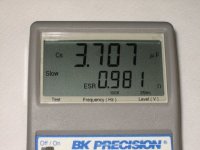philf
1 kW
So where do we send the coffee grinds and Red Bull?
Sleep deprivation + fechter = inspired ideas...
Great thread.
Sleep deprivation + fechter = inspired ideas...
Great thread.
There's probably another ingredient in there that I can't mention :wink:philf said:So where do we send the coffee grinds and Red Bull?
Sleep deprivation + fechter = inspired ideas...
Great thread.
fechter said:There's probably another ingredient in there that I can't mention :wink:philf said:So where do we send the coffee grinds and Red Bull?
Sleep deprivation + fechter = inspired ideas...
Great thread.
Microwave oven caps would be gross overkill.
Even motor starter caps would be huge.
From what I can tell, just little aluminum electrolytics work fine without too much heating. These are a little bigger than a pencil eraser.
I made some progress on parts selections and the cell circuit design.
Now I need a good half bridge circuit to generate the square wave. It would be best if I could find a switching controller chip that would drive both high and low side FETs at 50% duty cycle. There must be something like this, but there are so damn many of those things it takes a long time to search. I can always do it with discrete components.
I want something in a half bridge configuration that can pull up to the 5v (or whatever it takes) and pull down to ground. I only need about 2A, since that's what the bridges are rated at. Efficiency is not a big deal, but I don't want much heat generation.

heathyoung said:You need some dead time 48/48% duty is safestDon't ask me how I know this.
There are pleanty of IC's out there that will do what you need. Even a plain old boring SG3525 would do what you want, or a TL494 or... Totem pole drive your mosfets with BD139/140's and robert is your proverbial relation.
I'll see if I can dig up the notes I made when I did this for SLA string charging. Inrush current was handled by using an error amplifier on a shunt which controlled the PWM duty cycle - thats what these IC's are designed to do, no sense in reinventing the wheel.

fechter said:MLCC caps are funny. If you buy small quantities, they are astronomically expensive, but not too bad in lots of over 1000. MLCCs would solve the ESR problem and you could probably run them at very high frequencies. I'm not sure what an upper frequency limit for a schottky diode is.
lawsonuw said:Further, the two AC power rails could be ground referenced to the middle of a string of cells, this would effectively double the number of cells that could be reached with low voltage capacitors.
Yeah, there are. I have a databook from just ONE company that is bigger and almost as thick as my whole Mouser catalog.fechter said:More capacitor shopping... Man, there are a lot of these things.
Being able to use 50V caps is great news! As the knowledgeable Camlight mentions, these will not heat up even with over 2A of ripple current.fechter said:More capacitor shopping... Man, there are a lot of these things.
Since I'm planning on an isolated supply for the balance charger, there's no reason it can't be referenced to the middle of the pack, or module. A 24 series pack or module could then be done with 50v caps.
It seems there is a better selection and price on 50v rated caps.
Now this is a little tiny 1206 package that is barely big enough to see.
Datasheets don't say anything about maximum current
fechter said:More capacitor shopping... Man, there are a lot of these things.
lawsonuw said:Further, the two AC power rails could be ground referenced to the middle of a string of cells, this would effectively double the number of cells that could be reached with low voltage capacitors.
Since I'm planning on an isolated supply for the balance charger, there's no reason it can't be referenced to the middle of the pack, or module. A 24 series pack or module could then be done with 50v caps.
It seems there is a better selection and price on 50v rated caps.
Here's one I found at Mouser:
Mouser 810-C3216Y5V1H475Z
1206 4.7uF 50V Y5V +80/-20%
1: $0.11
50: $0.085
100: $0.077
Now this is a little tiny 1206 package that is barely big enough to see. I suspect that it won't be able to handle the amount of power I want to run through it, but how do you tell? Datasheets don't say anything about maximum current. These are Y5V too, which don't seem to be as good as the X7S varieties I was looking at. At $0.11ea, it would be OK to parallel them to get the required power and cheap enough to get some for destructive testing. A larger package would be better for hand building for sure.
